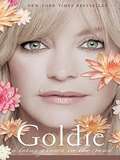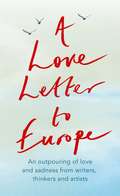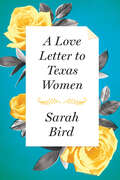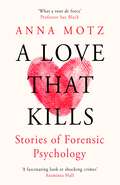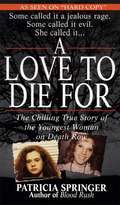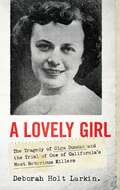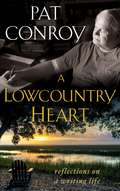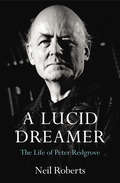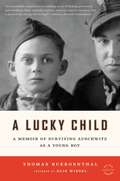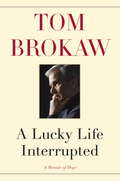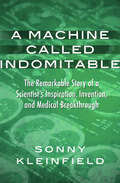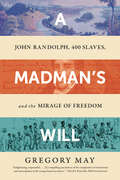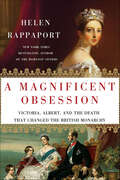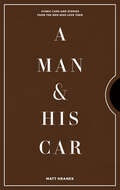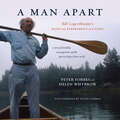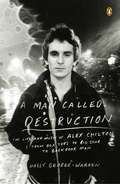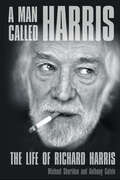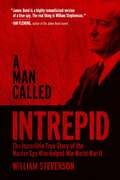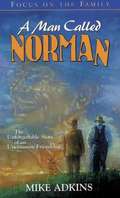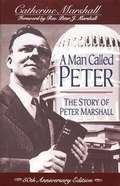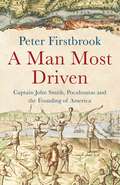- Table View
- List View
A Lotus Grows in the Mud (Thorndike Paperback Bestsellers Ser.)
by Goldie HawnWith her trademark effervescence, Goldie delivers a personal look at private and powerful events that carried her through life: her father's spontaneity; her mother's courage; and the joy of being a daughter, a sister, a parent, and a lover. She writes about her childhood dreams of becoming a ballerina. She takes us on a tour of her go-go years in 1960s New York City, the phenomenon of TV's Rowan & Martin's Laugh-In, her Oscar-winning debut in Cactus Flower and Hollywood stardom. She writes intimately about the challenges of love, anger and fear, and the importance of compassion and integrity. She speaks openly about her family, her partner Kurt Russell, her children; her faith, her curiosity for that which she doesn't yet know, and her thirst for knowledge. Most of all, it is a trip back through a life well lived by a woman well loved.
A Love Affair with Birds: The Life of Thomas Sadler Roberts
by Sue LeafThe father of Minnesota ornithology, whose life story opens a window on a lost world of nature and conservation in the state&’s early days Imagine a Minneapolis so small that, on calm days, the roar of St. Anthony Falls could be heard in town, a time when passenger pigeons roosted in neighborhood oak trees. Now picture a dapper professor conducting his ornithology class (the university&’s first) by streetcar to Lake Harriet for a morning of bird-watching. The students were mostly young women—in sunhats, sailor tops, and long skirts, with binoculars strung around their necks. The professor was Thomas Sadler Roberts (1858–1946), a doctor for three decades, a bird lover virtually from birth, the father of Minnesota ornithology, and the man who, perhaps more than any other, promoted the study of the state&’s natural history. A Love Affair with Birds is the first full biography of this key figure in Minnesota&’s past.Roberts came to Minnesota as a boy and began keeping detailed accounts of Minneapolis&’s birds. These journals, which became the basis for his landmark work The Birds of Minnesota, also inform this book, affording a view of the state&’s rich avian life in its early days—and of a young man whose passion for birds and practice of medicine in a young Minneapolis eventually dovetailed in his launching of the beloved Bell Museum of Natural History.Bird enthusiast, doctor, author, curator, educator, conservationist: every chapter in Roberts&’s life is also a chapter in the state&’s history, and in his story acclaimed author Sue Leaf—an avid bird enthusiast and nature lover herself—captures a true Minnesota character and his time.
A Love Letter to Europe: An outpouring of sadness and hope – Mary Beard, Shami Chakrabati, Sebastian Faulks, Neil Gaiman, Ruth Jones, J.K. Rowling, Sandi Toksvig and others
by Various Melvyn Bragg Lindsey Davis Pete Townshend Chris Cleave Chris Riddell Margaret Drabble Philip Ardagh Mary Beard William Dalrymple Will Hutton Holly Johnson Simon Callow Prue Leith Brian Catling Tony Robinson Tracey Emin Shami Chakrabarti Jonathan Meades Frank Cottrell Boyce J.K. Rowling Jeffrey Boakye Onjali Rauf Peter J ConradiHow are great turning points in history experienced by individuals?As Britain pulls away from Europe great British writers come together to give voice to their innermost feelings. These writers include novelists, writers of books for children, of comic books, humourists, historians, biographers, nature writers, film writers, travel writers, writers young and old and from an extraordinary range of backgrounds. Most are famous perhaps because they have won the Booker or other literary prizes, written bestsellers, changed the face of popular culture or sold millions of records. Others are not yet household names but write with depth of insight and feeling.There is some extraordinary writing in this book. Some of these pieces are expressions of love of particular places in Europe. Some are true stories, some nostalgic, some hopeful. Some are cries of pain. There are hilarious pieces. There are cries of pain and regret. Some pieces are quietly devastating. All are passionate.Conceived as a love letter to Europe, this book may also help reawaken love for Britain. It shows the unique richness and diversity of British cultures, a multitude of voices in harmony.Contributors include:Hugh Aldersey-Williams, Philip Ardagh, Jake Arnott, Patricia Atkinson, Paul Atterbury, Richard Beard, Mary Beard, Don Boyd, Melvyn Bragg, Gyles Brandreth, Kathleen Burke, James Buxton, Philip Carr, Brian Catling, Shami Chakrabarti, Chris Cleave, Mark Cocker, Peter Conradi , Heather Cooper, Frank Cottrell-Boyce, Roger Crowley, David Crystal, William Dalrymple, Lindsey Davies, Margaret Drabble, Mark Ellen, Richard Evans, Michel Faber, Sebastian Faulks, Ranulph Fiennes, Robert Fox, James Fox, Neil Gaiman, Evelyn Glennie, James Hanning, Nick Hayes, Alan Hollinghurst, Gabby Hutchinson-Crouch, Will Hutton, Robert Irwin, Holly Johnson , Liane Jones, Ruth Jones, Sam Jordison, Kapka Kassabova, AL Kennedy, Hermione Lee, Prue Leith, Patrick Lenox, Roger Lewis, David Lindo, Penelope Lively, Beth Lync, Richard Mabey, Sue MacGregor, Ian Martin, Frank McDonough, Jonathan Meades, Andrew Miller, Deborah Moggach, Ben Moor, Alan Moore, Paul Morley, Jackie Morris, Charles Nicholl, Richard Overy, Chris Riddell, Adam Roberts, Tony Robinson, Lee Rourke, Sophie Sabbage, Marcus Sedgwick, Richard Shirreff, Paul Stanford, Isy Suttie, Sandi Toksvig, Colin Tudge, Ed Vulliamy, Anna Whitelock, Kate Williams, Michael Wood, Louisa Young
A Love Letter to Texas Women
by Sarah Bird&“A laugh-out-loud 80-page personal history with heart, grit and a galaxy of stars,&” the perfect gift for a Texas woman or new transplant to the state (Austin American-Statesman) What is it that distinguishes Texas women—the famous Yellow Rose and her descendants? Is it that combination of graciousness and grit that we revere in first ladies Laura Bush and Lady Bird Johnson? The rapier-sharp wit that Ann Richards and Molly Ivins used to skewer the good ole boy establishment? The moral righteousness with which Barbara Jordan defended the US constitution? An unnatural fondness for Dr Pepper and queso? In her inimitable style, Sarah Bird pays tribute to the Texas woman in all her glory and all her contradictions. She humorously recalls her own early bewildered attempts to understand Lone Star gals, from the big-haired, perfectly made-up ladies at the Hyde Park Beauty Salon to her intellectual, quinoa-eating roommates at Seneca House Co-op for Graduate Women. After decades of observing Texas women, Bird knows the species as few others do. A Love Letter to Texas Women is a must-have guide for newcomers to the state and the ideal gift to tell any Yellow Rose how special she is. &“In her trademark bitingly funny style, Bird talks about her journey from granola hippydom in New Mexico to the Aqua-Netted friendliness of Texas, and how she learned to love it. Great stories and quotes from greats such as the late Ann Richards and Lady Bird Johnson to everyday ladies getting their hair set in small towns.&” ―San Antonio Express-News
A Love That Kills: Stories of Forensic Psychology and Female Violence
by Anna MotzFemale violence is a truth too uncomfortable for most to consider. We treat those who kill, abuse and commit terrible acts as outcasts - they are monsters, angels of death, manifestations of pure evil and a threat to the ideals of womanhood.In reality, the truth can be much more complex. Many women who commit acts of violence have been subjected to shocking abuse themselves. Some are suffering from serious mental illness or psychological harm. For many, the desperate search for the care they have been denied their whole lives leads them to repeat the same brutality they once suffered. Women like this are not the inhuman monsters of tabloid myth, but victims and proponents of abuse motivated by the most human instinct of all: to love and be loved.Introducing us to eleven ordinary women who came to commit extreme acts, Anna Motz - one of Britain's leading forensic psychotherapists who has spent three decades working with violent women - takes us on a journey into psychotherapy, uncovering their motives and the fault lines in their psyche that led to their crimes. We meet Mary, who turned to arson after her son was taken into care, Maja, whose fantasy life led to her stalking an ex-boyfriend, and Dolores, whose terrible crime is unimaginable to most people. Deeply affecting, compelling and profound, A Love That Kills offers a rare insight into the sometimes perilous dance between therapist and patient and the often tortuous pathways to recovery, asking vital questions about how society treats violent women.
A Love To Die For
by Patricia SpringerOn January 12, 1995, in Knoxville, Tennessee, 19year old Colleen Slemmer went for a walk with her friend 18-year-old Christa Pike. Suddenly, Christa turned on Colleen, accusing her of flirting with her boyfriend. Then the words turned to shocking blows. An enraged Christa used a box knife to cut her rival's throat and a mini meat cleaver to inflict more havoc. Half-naked, Colleen crawled through her own blood begging for her life. In the middle of the hour-long assault, a satanic symbol was carved in the dying girl's chest. And when Christa was finally done, she took a piece of Colleen's skull as a macabre souvenir. What were the dark forces that drove angelic-faced Christa to commit such a savage murder and become the youngest woman ever to be put on Death Row? In this shocking expose of a case that stunned the nation, Patricia Springer takes us through a horrifying crime scene and into the heart and mind of a murderess who killed for love-and would die for it, too.
A Lovely Girl: The Tragedy of Olga Duncan and the Trial of One of California's Most Notorious Killers
by Deborah Holt LarkinThe incredible story of a 1958 murder that ended with the last woman to ever be executed in California—a murder so twisted it seems ripped from a Greek tragedy.Deborah Larkin was only ten years old when the quiet calm of her California suburb was shattered. Thirty miles north, on a quiet November night in Santa Barbara, a pregnant nurse named Olga Duncan disappeared from her apartment. The mystery deepens when it is discovered that Olga&’s mother in-law—a deeply manipulative and deceptive woman—had been doing everything in her power to separate Olga and her son, Frank, prior to Olga&’s disappearance. From a forged annulment to multiple attempts to hire people to &“get rid&” of Olga, to a faked excoriation case, Elizabeth seemed psychopathically attached to her son. Yet she denied having anything to do with Olga&’s disappearance with a smile. But when Olga&’s brutally beaten body is found in a shallow grave, apparently buried alive, a young DA makes it his mission to see that Elizabeth Duncan is brought to justice. Adding a wrinkle to his efforts is the fact that Frank—himself a defense attorney—maintained his mother&’s innocent to the end. How does a young girl process such a crime along with the fear and disbelieve that rocked an entire community? Decades later, Larkin is determined to revisit the case and bring the story of Olga herself to light. Long overshadowed by the sensationalism and scandal of Elizabeth and Frank, A Lovely Girl seeks to reveal Olga as a woman in full. Someone who was more than the twisted family that would ultimately ensnare her. As we follow the heart-pounding drama of the case through Larkin's young eyes—her father was the court reporter—A Lovely Girl is by turns page-turning yet poingnant, and makes the reader reexamine how we handle fear, how we regard mental illness, and how we understand family as we carve our own path in a dangerous world.
A Lowcountry Heart: Reflections on a Writing Life
by Pat Conroy<P>Final words and heartfelt remembrances from bestselling author Pat Conroy take center stage in this winning nonfiction collection, supplemented by touching pieces from Conroy's many friends. <P>This new volume of Pat Conroy's nonfiction brings together some of the most charming interviews, magazine articles, speeches, and letters from his long literary career, many of them addressed directly to his readers with his habitual greeting, "Hey, out there." Ranging across diverse subjects, such as favorite recent reads, the challenge of staying motivated to exercise, and processing the loss of dear friends, Conroy's eminently memorable pieces offer a unique window into the life of a true titan of Southern writing. <P>With a beautiful introduction from his widow, novelist Cassandra King, A Lowcountry Heart also honors Conroy's legacy and the innumerable lives he touched. Finally, the collection turns to remembrances of "The Great Conroy," as he is lovingly titled by friends, and concludes with a eulogy. The inarguable power of Conroy's work resonates throughout A Lowcountry Heart, and his influence promises to endure. <P>This moving tribute is sure to be a cherished keepsake for any true Conroy fan and remain a lasting monument to one of the best-loved masters of contemporary American letters. <P><b>A New York Times Bestseller</b>
A Lucid Dreamer: The Life of Peter Redgrove
by Peter Redgrove Dr Neil RobertsThe work of the poet Peter Redgrove is one of the great unexplored treasures of late twentieth century literature. His prolific output presents an intriguing variety of personae: magician, scientist, lover, psychologist, joker, madman. It is only now, with the publication of his Collected Poems and this biography, that we can see how and why these personae developed - and discover the full depth and range of this visionary writer.Born into an apparently conventional middle-class family that was in reality deeply disturbed, the poet finally emerged: transforming himself from the neurotic, Oedipal young scientist, through a process of mental breakdown, insulin coma therapy, erotic revelation and the discovery of poetic companionship at Cambridge - and particularly his friendship and rivalry with Ted Hughes.Neil Roberts explores the inner story of this emergence, and Redgrove's later development through marriage, family life, the fellowship of the 'Group', alcoholic excess, infidelity and marital breakdown to his triumphant later partnership with Penelope Shuttle. We also discover, for the first time, some darker secrets: his fascination with Aleister Crowley, his damaged and damaging relationship with his father, and the lifelong sexual fetish which he called the 'Game'. Drawing on the poet's intimate journals and correspondence, and interviews with family, friends and colleagues, A Lucid Dreamer tells the exceptionally inward and revealing story of an astonishing creative life.
A Lucky Child: A Memoir of Surviving Auschwitz as a Young Boy
by Elie Wiesel Thomas BuergenthalThomas Buergenthal, now a Judge in the International Court of Justice in The Hague, tells his astonishing experiences as a young boy in his memoir A LUCKY CHILD. He arrived at Auschwitz at age 10 after surviving two ghettos and a labor camp. Separated first from his mother and then his father, Buergenthal managed by his wits and some remarkable strokes of luck to survive on his own. Almost two years after his liberation, Buergenthal was miraculously reunited with his mother and in 1951 arrived in the U.S. to start a new life.Now dedicated to helping those subjected to tyranny throughout the world, Buergenthal writes his story with a simple clarity that highlights the stark details of unimaginable hardship. A LUCKY CHILD is a book that demands to be read by all.
A Lucky Life Interrupted
by Tom BrokawFrom Tom Brokaw, the bestselling author of The Greatest Generation, comes a powerful memoir of a year of dramatic change--a year spent battling cancer and reflecting on a long, happy, and lucky life. Tom Brokaw has led a fortunate life, with a strong marriage and family, many friends, and a brilliant journalism career culminating in his twenty-two years as anchor of the NBC Nightly News and as bestselling author. But in the summer of 2013, when back pain led him to the doctors at the Mayo Clinic, his run of good luck was interrupted. He received shocking news: He had multiple myeloma, a treatable but incurable blood cancer. Friends had always referred to Brokaw's "lucky star," but as he writes in this inspiring memoir, "Turns out that star has a dimmer switch." Brokaw takes us through all the seasons and stages of this surprising year, the emotions, discoveries, setbacks, and struggles--times of denial, acceptance, turning points, and courage. After his diagnosis, Brokaw began to keep a journal, approaching this new stage of his life in a familiar role: as a journalist, determined to learn as much as he could about his condition, to report the story, and help others facing similar battles. That journal became the basis of this wonderfully written memoir, the story of a man coming to terms with his own mortality, contemplating what means the most to him now, and reflecting on what has meant the most to him throughout his life. Brokaw also pauses to look back on some of the important moments in his career: memories of Nelson Mandela, the Dalai Lama, the fall of the Berlin Wall, the morning of September 11, 2001, in New York City, and more. Through it all, Brokaw writes in the warm, intimate, natural voice of one of America's most beloved journalists, giving us Brokaw on Brokaw, and bringing us with him as he navigates pain, procedures, drug regimens, and physical rehabilitation. Brokaw also writes about the importance of patients taking an active role in their own treatment, and of the vital role of caretakers and coordinated care. Generous, informative, and deeply human, A Lucky Life Interrupted offers a message of understanding and empowerment, resolve and reality, hope for the future and gratitude for a well-lived life.From the Hardcover edition.
A Machine Called Indomitable: The Remarkable Story of a Scientist's Inspiration, Invention, and Medical Breakthrough
by Sonny KleinfieldThe true story of the doctor who invented the MRI: &“A fascinating account of how a significant medical development came about&” (The New York Times). Dr. Raymond Damadian was plagued with a mysterious and persistent stomach pain, yet physicians assured him that they could find nothing wrong. To find the answer to his ailment, Damadian would spend the ensuing twelve years building a machine that would change medicine. Nuclear magnetic resonance scanning, now called magnetic resonance imaging (MRI), was a revolution: a safe means to determine the makeup of every cell in the human body, distinguishing healthy cells from sick. Although Damadian&’s ideas were met with skepticism and outright opposition from the medical community, this machine would go on to save the lives of millions by diagnosing disease while effective treatment was still possible. In short, it was a medical miracle. The story of Damadian&’s quest—battling skeptical peers, money troubles, and more with an intensity approaching obsession—is one of the great legends of medical research. Sonny Kleinfield, acclaimed reporter and author, captures Damadian&’s remarkable triumph against the odds with compassion and a keen eye. A Machine Called Indomitable is scientific storytelling at its finest.
A Mad, Crazy River: Running the Grand Canyon in 1927
by Clyde L. EddyWhen Clyde Eddy first saw the Colorado River in 1919, he vowed that he would someday travel its length. Eight years later, Eddy recruited a handful of college students to serve as crewmen and loaded them, a hobo, a mongrel dog, a bear cub, and a heavy motion picture camera into three mahogany boats and left Green River, Utah, headed for Needles, California. Forty-two days and eight hundred miles later, they were the first to successfully navigate the river during its annual high water period. This book is the original narrative of that foolhardy and thrilling adventure.&“The point of his great adventure is not to make a name for himself, or to profit from a documentary film, or even to prove that quiet men of intellect can be as courageous as brawny frontiersmen. The point is the journey itself, the satisfaction of attempting the near impossible, and of surviving to tell the tale.&”--Peter Miller, National Geographic Magazine, from the Foreword
A Madman's Will: John Randolph, Four Hundred Slaves, and the Mirage of Freedom
by Gregory MayThe untold saga of John Randolph’s 383 slaves, freed in his much-contested will of 1821, finally comes to light. Few legal cases in American history are as riveting as the controversy surrounding the will of Virginia Senator John Randolph (1773–1833), which—almost inexplicably—freed all 383 of his slaves in one of the largest and most publicized manumissions in American history. So famous is the case that Ta-Nehisi Coates has used it to condemn Randolph’s cousin, Thomas Jefferson, for failing to free his own slaves. With this groundbreaking investigation, historian Gregory May now reveals a more surprising story, showing how madness and scandal shaped John Randolph’s wildly shifting attitudes toward his slaves—and how endemic prejudice in the North ultimately deprived the freedmen of the land Randolph had promised them. Sweeping from the legal spectacle of the contested will through the freedmen’s dramatic flight and horrific reception in Ohio, A Madman’s Will is an extraordinary saga about the alluring promise of freedom and its tragic limitations.
A Magnificent Obsession: Victoria, Albert, and the Death That Changed the British Monarchy
by Helen RappaportAs she did in her critically acclaimed The Last Days of the Romanovs, Helen Rappaport brings a compelling documentary feel to the story of this royal marriage and of the queen's obsessive love for her husband – a story that began as fairy tale and ended in tragedy.After the untimely death of Prince Albert, the queen and her nation were plunged into a state of grief so profound that this one event would dramatically alter the shape of the British monarchy. For Britain had not just lost a prince: during his twenty year marriage to Queen Victoria, Prince Albert had increasingly performed the function of King in all but name. The outpouring of grief after Albert's death was so extreme, that its like would not be seen again until the death of Princess Diana 136 years later. Drawing on many letters, diaries and memoirs from the Royal Archives and other neglected sources, as well as the newspapers of the day, Rappaport offers a new perspective on this compelling historical psychodrama--the crucial final months of the prince's life and the first long, dark ten years of the Queen's retreat from public view. She draws a portrait of a queen obsessed with her living husband and – after his death – with his enduring place in history. Magnificent Obsession will also throw new light on the true nature of the prince's chronic physical condition, overturning for good the 150-year old myth that he died of typhoid fever.
A Man & His Car: Iconic Cars and Stories from the Men Who Love Them
by Matt HranekMan-about-town and NYC men&’s style fixture Matt Hranek is back with his second book, A Man & His Car. Here is a beautiful homage to an object of men&’s obsession, told in firsthand and original interviews. Jay Leno, a major car collector and the host of Jay Leno&’s Garage, shares the story of his oldest car, a 1955 Buick Roadmaster that he bought for $350, which he literally slept in before getting his break in L.A. Kevin Costner reveals that he got so attached to the iconic Shelby Mustang he drove in the movie Bull Durham, he bought it for his own personal collection. Franz von Holzhausen, chief designer at Tesla, who worked hand in hand with Elon Musk to design the Tesla Model S prototype, says that his love of cars started when he was two (as evidenced by a picture of him sitting in a high chair drawing a car). And as for Snoop Dogg and his 1965 Cadillac &“Snoop DeVille&” convertible—do we even need to explain?A Man & His Car includes visits to some of the most exclusive collections in the world—from that of the Petersen Automotive Museum to those of car manufacturers from Fiat to Ford—giving us access to Steve McQueen&’s favorite car, a 1956 Jaguar XKSS; the 1971 DeTomaso Pantera that Elvis purchased for his then-girlfriend Linda Thompson (and which has two bullet holes in the steering wheel and one in the driver&’s-side floorpan from when, after an altercation with Thompson, Presley fired three rounds into the interior when the car wouldn&’t start); and a super-rare, 24-karat-gold-plated 1980 DeLorean DMC-12, a model that was sold exclusively to American Express Gold Card members through the 1980 American Express catalog, for an astronomical $85,000 (equivalent to more than $250,000 today). Exquisite photos of each car accompany each story, and since cars naturally hold more detail than watches, there will be more photos in this book—of the cars head-on, of their hood ornaments and wheels, and of course full-body shots. With Hranek&’s storytelling, the cars become more than just vehicles for transportation and status symbols; they represent pop-culture moments, pioneering achievements, heirlooms, friendships, and more.
A Man Apart: Bill Coperthwaite's Radical Experiment in Living
by Peter Forbes Helen WhybrowA story of friendship, encouragement, and the quest to design a better worldA Man Apart is the story—part family memoir and part biography—of Peter Forbes and Helen Whybrow&’s longtime friendship with Bill Coperthwaite (A Handmade Life), whose unusual life and fierce ideals helped them examine and understand their own.Coperthwaite inspired many by living close to nature and in opposition to contemporary society, and was often compared to Henry David Thoreau. Much like Helen and Scott Nearing, who were his friends and mentors, Coperthwaite led a 55-year-long &“experiment in living&” on a remote stretch of Maine coast. There he created a homestead of wooden, multistoried yurts, a form of architecture for which he was known around the world.Coperthwaite also embodied a philosophy that he called &“democratic living,&” which was about empowering all people to have agency over their lives in order to create a better community. The central question of Coperthwaite&’s life was, &“How can I live according to what I believe?&”In this intimate and honest account—framed by Coperthwaite&’s sudden death and brought alive through the month-long adventure of building with him what would turn out to be his last yurt—Forbes and Whybrow explore the timeless lessons of Coperthwaite&’s experiment in intentional living and self-reliance. They also reveal an important story about the power and complexities of mentorship: the opening of one&’s life to someone else to learn together, and carrying on in that person&’s physical absence.While mourning Coperthwaite&’s death and coming to understand the real meaning of his life and how it endures through their own, Forbes and Whybrow craft a story that reveals why it&’s important to seek direct experience, to be drawn to beauty and simplicity, to create rather than critique, and to encourage others.
A Man Born Again: Saint Thomas More
by John E. BeahnStatus and wealth, power and fame, St. Thomas More had them all. As a wise and popular statesman, internationally recognized scholar and lord chancelor of England. It was perhaps the most highly respected Englishman of his day until his conscience required that he lay down his life for his Catholic faith. In this book makes ample use of the rich historical record of 16th century England.
A Man Called Destruction
by Holly George-WarrenThe first biography of the influential musician and forebear of the indie-rock scene Alex Chilton's story is rags to riches in reverse, beginning with teenage rock stardom and heading downward. Following stints leading 60s sensation the Box Tops ("The Letter") and pioneering 70s popsters Big Star ("the ultimate American pop band"--Time), Chilton became a dishwasher. Yet he rose again in the 80s as a solo artist, producer, and trendsetter, coinventing the indie-rock genre. By the 90s, acolytes from R.E.M. to Jeff Buckley embodied Chilton's legacy, ushering him back to the spotlight before his untimely death in 2010. In the career-spanning and revelatory A Man Called Destruction, longtime Chilton acquaintance Holly George-Warren has interviewed more than 100 bandmates, friends, and family members to flesh out a man who presided over--and influenced--four decades of American musical history, rendered here with new perspective through the adventures of a true iconoclast.
A Man Called Destruction
by Holly George-WarrenThe first biography of the artist who "essentially invented indie and alternative rock" (Spin)A brilliant and influential songwriter, vocalist, and guitarist, the charismatic Alex Chilton was more than a rock star--he was a true cult icon. Awardwinning music writer Holly George-Warren's A Man Called Destruction is the first biography of this enigmatic artist, who died in 2010. Covering Chilton's life from his early work with the charttopping Box Tops and the seminal power-pop band Big Star to his experiments with punk and roots music and his sprawling solo career, A Man Called Destruction is the story of a musical icon and a richly detailed chronicle of pop music's evolution, from the mid-1960s through today's indie rock.
A Man Called Harris: The Life of Richard Harris
by Anthony Galvin Michael SheridanRichard Harris was a giant who oozed charisma on screen. But off screen he was troubled and addicted to every pleasure life could offer. Coming from a repressed Irish Catholic background, he was forced by a teenage illness to abandon his beloved rugby, but not his macho appetites. Discovering theatre saved him. He had found his calling. Despite marrying the daughter of a peer, he never tried to fit in. He was always a hell-raiser to the core, along with legendary buddies Richard Burton and Peter O’Toole. But he was more; he was a gifted poet and singer. He was an intelligent family man who took great interest in his craft, a Renaissance man of the film world. Every time his excesses threatened to kill his career – and himself – he rose magnificently from the ashes, first with an Oscar-winning performance as Bull McCabe in The Field, then in the Harry Potter franchise.
A Man Called Intrepid: The Incredible True Story of the Master Spy Who Helped Win World War II (Lyons Press Ser.)
by William StevensonThe classic real-life story of the superspy whose vast intelligence network helped defeat the Nazis in World War II.A Man Called Intrepid is the account of the world's first integrated intelligence operation and of its master, William Stephenson. Codenamed INTREPID by Winston Churchill, Stephenson was charged with establishing-and running-a vast, worldwide intelligence network to challenge the terrifying force of Nazi Germany. Nothing less than the fate of Britain and the free world hung in the balance as INTREPID covertly set about stalling the Nazis by any means necessary.First published in 1976, A Man Called Intrepid was an immediate bestseller. With over thirty black-and-white photographs and countless World War II secrets, this book revealed startling information that had remained buried for decades. Detailing the infamous "Camp X" training center in Ontario, Canada; the miraculous breaking of the Ultra Code used by the Enigma Machine; and dozens of other stories of clandestine missions, A Man Called Intrepid is an undisputed modern classic.
A Man Called Norman
by Mike AdkinsThis is the moving story of two men, an eccentric old man and a Christian musician, whose lives intertwine in a way that neither would have expected and only God could have planned.
A Man Called Peter: The Story Of Peter Marshall
by Catherine Marshall Peter MarshallAn instant bestseller in 1951, this is the compelling story of Peter Marshall, the Scottish immigrant who became chaplain of the U. S. Senate.
A Man Most Driven: Captain John Smith, Pocahontas And The Founding Of America
by Peter FirstbrookNamed a Best Book of 2014 by The Providence Journal "A nuanced account of the English captain saved by Pocahontas reveals an astonishingly complicated personality. Former BBC producer Firstbrook finds in the roguish, quarrelsome, fearless adventurer Capt. John Smith a sterling example of the tenacious early-American character. . . . Exciting historical tales with romantic overtones. " - Kirkus Reviews Everyone knows the story of Pocahontas and how she saved John Smith. And were it not for Smith’s leadership, the Jamestown Colony would surely have failed. Yet Smith was a far more ambitious explorer and soldier of fortune than these tales suggest--and a far more ambitious self-promoter, too, so reputed for his truculence that the pilgrims of the Mayflower snubbed him when he offered them his services, though his 1614 map of New England (which he named) made him the unrivaled expert on America. Now, in the first major biography of Smith in decades, award-winning BBC filmmaker and author Peter Firstbrook traces the adventurer’s astonishing exploits across three continents, testing Smith’s claimed biography against the historical and geographical reality on the ground. A Man Most Driven delivers an enlightening dissection of this mythology-making man and the invention of America.
